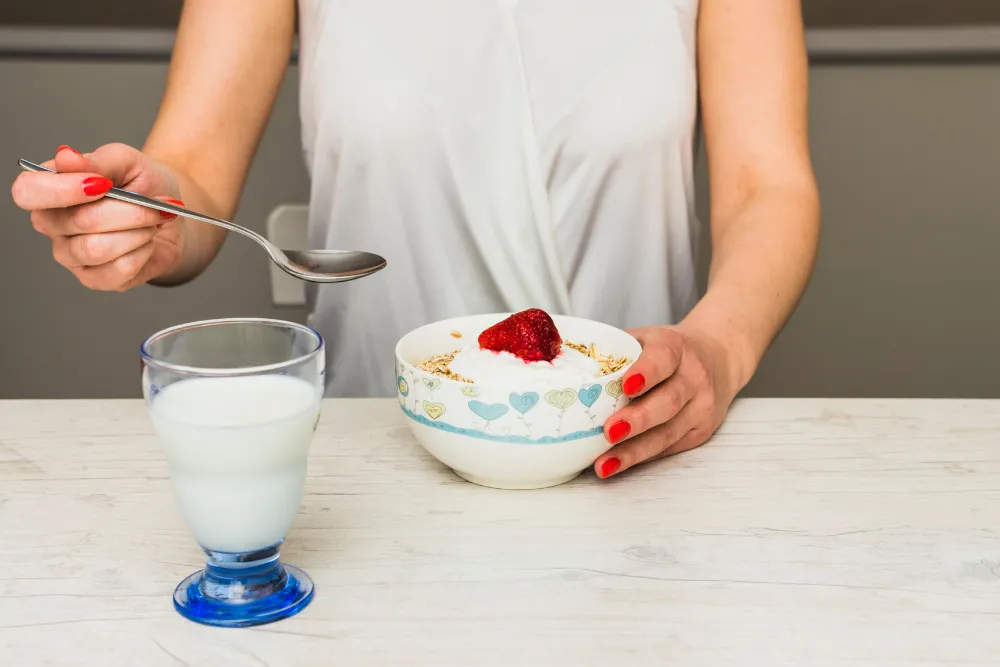Introduction
Many people consider yogurt a healthy snack, but when it comes in a colorful tube like Gogurt, many parents and health-conscious individuals start to wonder if it’s still good for them. There is more to the tale than just vibrant packaging and interesting tastes when we look closely at the nutrition statistics for Gogurt.
This article will tell you everything you need to know about Gogurt nutrition facts, including how many calories, sugar, protein, and probiotics it has. It will also tell you about a surprising benefit that makes this snack more than just a kid’s treat.
What is Gogurt?

Gogurt is a kind of yogurt that comes in a tube that you can squeeze and consume on the move. Yoplait creates it, and kids love it because it makes yogurt exciting and easy to take with them.
Parents check Gogurt nutrition facts to see if this colorful snack is really nutritious or merely sugary, just like consumers check Four Loko nutrition facts to determine how safe or strong an energy-alcohol cocktail is. Both of these things remind us that we should always glance at the nutrition labels on meals that appear fun first.
Gogurt Nutrition Facts: A Quick Overview
Let’s look at the nutrition facts for Gogurt based on a typical serving size, which is one tube, or around 2 ounces (56 grams).
In one serving, you usually get this:
- Calories: 50–60
- There are 0 to 1 grams of total fat.
- Two grams of protein
- About 9 to 10 grams of sugar
- Calcium: About 10% of the daily value
- Added vitamin D to help bones.
These Gogurt nutrition facts are quite standard for most classic Yoplait Gogurts but some flavors or kinds may have slightly different ones.
At first glance, it could look like there isn’t enough protein and too much sugar but the unexpected fact is that Gogurt still has some good nutrients for kids and people who are busy.
What Do the Calories in Gogurt Mean?

Calories are a way to measure energy. The nutrition facts for Gogurt say that one tube has about 50 to 60 calories. That number is rather low compared to a lot of other munchies, such as chips or cookies which may easily have more than 150 calories per serving. This is similar to how people use tools like a nutrition calculator Qdoba to check the calories in different meals before they order.
For kids, this small calorie content makes Gogurt a light snack rather than a full meal. It offers them a little extra energy between meals without adding too many calories to their diet. This is also why parents and fitness trackers sometimes use things like a nutrition calculator Qdoba to keep track of how many calories they eat each day.
Is the sugar too sweet or just right?
When people look at the nutrition data for Gogurt, one of the most common things they worry about is the sugar content. People who analyze Jevity 1.5 nutrition to assess the sugar and nutrient balance in medical-grade nutrition formulae could worry if 9–10 grams of sugar in each tube is too much.
The truth is that Gogurt has both natural milk sugars (lactose) and sugars that were added to make it taste better. Flavored varieties, such as strawberry or berry blast, usually feature extra sugars.
Gogurt is substantially lighter than a can of soda, which can have more than 35 grams of sugar. Soda can’t provide you with calcium and vitamin D, but this can.
Gogurt Simply and Gogurt Low-Fat Yogurt are two options for parents who wish to cut down on sugar. They have less added sugar.
Gogurt has a little bit of protein, which is good.

Protein is one of the most necessary things for the body to create and repair muscles. Gogurt nutrition facts says that each tube has roughly 2 grams of protein.
Even if that’s not a lot, it still adds to what you consume every day, especially for youngsters who don’t eat a lot of meat or eggs. When coupled with other protein-rich foods over the day, Gogurt nutrition facts help fill in those little nutritional gaps.
The Hidden Strength: Calcium and Vitamin D
Now for the fun part: this is when the Gogurt nutrition facts show something unexpected. Gogurt is small, yet it gives you about 10% of your daily calcium needs and has extra vitamin D.
Calcium is good for your bones and teeth, and vitamin D helps your body absorb that calcium better. That’s a strong mix, especially for kids and teens who are still growing.
Many people think of Gogurt as “just a fun snack,” but the nutrition facts demonstrate that it can actually help keep bones healthy in a minor but important way.
Very little fat and cholesterol
One good thing about Gogurt nutrition facts is that it has very little fat and sometimes none at all. There is normally 0 to 1 gram of fat and no cholesterol in each tube.
This makes it a better choice for your heart than other creamy treats like ice cream or pudding. Gogurt is a great choice if you’re trying to monitor how much fat you eat or keep your snacks minimal.
Probiotics: The Unexpected Gut Friendly Thing
The major surprise in Gogurt nutrition facts is that it has living and active cultures. These are probiotics, which are “good bacteria” that help your digestive system perform well.
Many people think that probiotics can help their gut health, boost their immune system, and make digestion easier. That means that eating Gogurt nutrition facts can really help keep your tummy happy and balanced.
This is one of the most important things about Gogurt nutrition facts that a lot of people, especially kids, don’t notice.
Gogurts Come in Different Flavors and Choices
There are many kinds and tastes of gogurt, from conventional strawberry and blueberry to tropical fruit mixes. The dietary statistics for Gogurt vary a little bit depending on the kind:
- Original Gogurt: made with regular sugar and milk
- Gogurt Simply: No fake colors or high-fructose corn syrup
- Gogurt Slushie: Based on frozen drinks, but with a little more sugar
- Gogurt Cotton Candy: Tastes good, but has less protein
The Gogurt Simply version is the best choice for kids because it tastes good and is better for them.
Gogurt vs. Regular Yogurt
There are certain distinctions between Gogurt and regular yogurt when it comes to nutrition facts:
- Size of the Portions: Gogurt comes in little tubes, whereas ordinary yogurt cups are bigger.
- Sugar Levels: Gogurt may contain more sugar per ounce, but because it is so tiny, it has less sugar overall.
- Convenience: Gogurt doesn’t need a spoon, which makes it easier to take to school or on trips.
- Probiotics: Both have them, but Gogurt makes them fun for kids to eat every day.
Gogurt is better than regular yogurt since it is easier to carry and is better for kids.
Who Can Use Gogurt?
Looking at Gogurt nutrition facts, this snack fits well for numerous categories of people:
- Kids: For growing bones and a tasty light snack.
- Teens: For a fast boost of energy between courses or sports.
- Adults: A quick low-calorie choice when you want something light.
- Parents: This is a simple approach to get youngsters to eat dairy and probiotics without any trouble.
Adults can also enjoy the same Gogurt nutrition facts benefits, such as low calories, probiotics that are good for the gut and quick nutrition on the go.
How to Make Gogurt Healthier
Here are some basic ideas to help you get the most out of Gogurt nutrition facts:
- Put it in the freezer: Frozen Gogurt is a fun snack that tastes like ice cream but has fewer calories.
- Pair it: Eat it with fruit, nuts, or granola to provide more protein and fiber.
- Pick better options: Choose Gogurt Simply or low-sugar versions.
- Limit how often you eat them. One or two tubes a day is OK, but make sure to eat other whole meals as well.
- Look at the label: Nutrition values can be a little variable for different varieties.
With these small changes you can still enjoy Gogurt and be healthy and balanced.
Why it’s important to know the nutrition facts on Gogurt
If you know the nutritional information about Gogurt nutrition facts it might help you pick better snacks. It’s not just about how many calories or how much sugar you eat.
When you know whats in your food you can plan when and how to eat it. That’s why it’s important to read the nutrition facts on Gogurt: it helps you choose healthy snacks.
FAQS
2. Is Gogurt still good for you when it's frozen?
Yes, freezing Gogurt doesn't take away its nutrients. It still has probiotics and calcium. It merely turns into a chilly ice pop, which a lot of youngsters prefer on hot days.
3. Is it safe for toddlers and tiny kids to eat Gogurt?
Yes, tiny kids who can consume soft foods can have Gogurt. But adults should check the sugar content and, if they can, choose simpler flavours like plain or low-sugar ones.
4. Does Gogurt assist your stomach?
Yes, Gogurt has live probiotics in it. These are small helpful bacteria that help the stomach perform better. They help with digestion and make the stomach feel better and healthier.
5. Is Gogurt a good snack for school?
Yes, Gogurt is a popular snack for school because it's convenient to carry, doesn't need a spoon, and offers you a little energy. Parents merely need to keep it cool to keep it safe.
The end
At first Gogurt could look like a basic kids’ snack with too much sugar and vivid colors. But if you look at the nutrition information for Gogurt, you’ll notice that it’s more than that. It has a little amount of protein, calcium, vitamin D and probiotics all in one fun, easy-to-use tube.
The unexpected health benefit of Gogurt is that it has probiotics and calcium, which are good for both your bones and your intestines.
So, the next time you pack a lunch or need a fast snack keep in mind that Gogurt nutrition facts reveal that it’s not only yummy but also smart.














